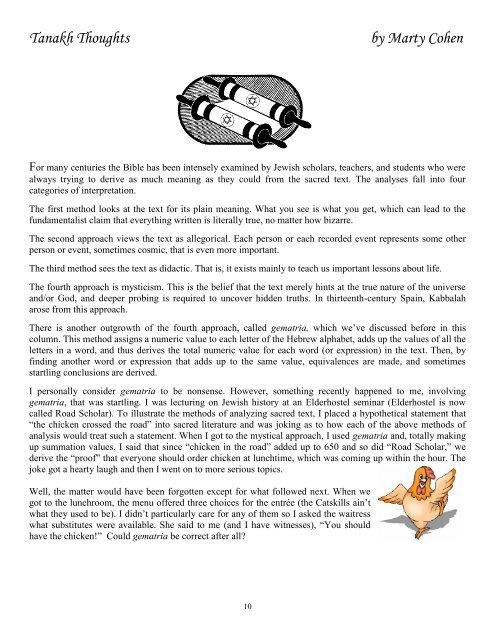The Rabbi's Desk: Hugging Trees Rabbi Craig Scheff
The Rabbi's Desk: Hugging Trees Rabbi Craig Scheff
The Rabbi's Desk: Hugging Trees Rabbi Craig Scheff
You also want an ePaper? Increase the reach of your titles
YUMPU automatically turns print PDFs into web optimized ePapers that Google loves.
Tanakh Thoughts by Marty Cohen<br />
For many centuries the Bible has been intensely examined by Jewish scholars, teachers, and students who were<br />
always trying to derive as much meaning as they could from the sacred text. <strong>The</strong> analyses fall into four<br />
categories of interpretation.<br />
<strong>The</strong> first method looks at the text for its plain meaning. What you see is what you get, which can lead to the<br />
fundamentalist claim that everything written is literally true, no matter how bizarre.<br />
<strong>The</strong> second approach views the text as allegorical. Each person or each recorded event represents some other<br />
person or event, sometimes cosmic, that is even more important.<br />
<strong>The</strong> third method sees the text as didactic. That is, it exists mainly to teach us important lessons about life.<br />
<strong>The</strong> fourth approach is mysticism. This is the belief that the text merely hints at the true nature of the universe<br />
and/or God, and deeper probing is required to uncover hidden truths. In thirteenth-century Spain, Kabbalah<br />
arose from this approach.<br />
<strong>The</strong>re is another outgrowth of the fourth approach, called gematria, which we’ve discussed before in this<br />
column. This method assigns a numeric value to each letter of the Hebrew alphabet, adds up the values of all the<br />
letters in a word, and thus derives the total numeric value for each word (or expression) in the text. <strong>The</strong>n, by<br />
finding another word or expression that adds up to the same value, equivalences are made, and sometimes<br />
startling conclusions are derived.<br />
I personally consider gematria to be nonsense. However, something recently happened to me, involving<br />
gematria, that was startling. I was lecturing on Jewish history at an Elderhostel seminar (Elderhostel is now<br />
called Road Scholar). To illustrate the methods of analyzing sacred text, I placed a hypothetical statement that<br />
―the chicken crossed the road‖ into sacred literature and was joking as to how each of the above methods of<br />
analysis would treat such a statement. When I got to the mystical approach, I used gematria and, totally making<br />
up summation values, I said that since ―chicken in the road‖ added up to 650 and so did ―Road Scholar,‖ we<br />
derive the ―proof‖ that everyone should order chicken at lunchtime, which was coming up within the hour. <strong>The</strong><br />
joke got a hearty laugh and then I went on to more serious topics.<br />
Well, the matter would have been forgotten except for what followed next. When we<br />
got to the lunchroom, the menu offered three choices for the entrée (the Catskills ain’t<br />
what they used to be). I didn’t particularly care for any of them so I asked the waitress<br />
what substitutes were available. She said to me (and I have witnesses), ―You should<br />
have the chicken!‖ Could gematria be correct after all?<br />
10


